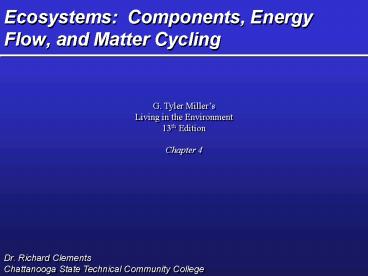Ecosystems: Components, Energy Flow, and Matter Cycling - PowerPoint PPT Presentation
1 / 25
Title:
Ecosystems: Components, Energy Flow, and Matter Cycling
Description:
Fig. 4-20 p. 79. Primary Productivity of Ecosystems. Gross primary productivity (GPP) ... Fig. 4-25 p. 81. Connections: Matter Cycling in Ecosystems ... – PowerPoint PPT presentation
Number of Views:153
Avg rating:3.0/5.0
Title: Ecosystems: Components, Energy Flow, and Matter Cycling
1
Ecosystems Components, Energy Flow, and Matter
Cycling
G. Tyler Millers Living in the Environment 13th
Edition Chapter 4
Dr. Richard Clements Chattanooga State Technical
Community College
2
Key Concepts
- Basic ecological principles
- Major components of ecosystems
- Matter cycles and energy flow
- Ecosystem studies
- Ecological services
3
The Nature of Ecology
- Ecosystem organization
- Organisms
- Populations
- Communities
- Ecosystems
- Biosphere
Fig. 4-2 p. 66
4
The Earths Life-Support Systems
- Troposphere
- Stratosphere
- Hydrosphere
- Lithosphere
- Biosphere
Fig. 4-6 p. 68
5
Sustaining Life of Earth
- One-way flowof energy
- Cycling ofmatter
Fig. 4-7 p. 69
6
The Source of Energy
Fig. 4-8 p. 69
7
Ecosystem Concepts and Components
- Biomes
- Role of climate
- Aquatic life zones
Fig. 4-9 p. 70
8
Ecosystem Boundaries Ecotones
Fig. 4-10 p. 71
9
Principles of Ecological Factors
- Abiotic factors
- Law of tolerance
- Biotic factors
- Limiting factors
Fig. 4-14 p. 73 Refer to Fig. 4-13 p. 73
10
The Biotic Components of Ecosystems
- Producers(autotrophs)
- Photosynthesis
- Consumers(heterotrophs)
- Aerobicrespiration
- Decomposers
Fig. 4-16 p. 75
11
Trophic Levels
- Primary consumer (herbivore)
- Secondary consumer (carnivore)
- Tertiary consumer
- Omnivore
- Detritivores and scavengers
- Decomposers
12
Biodiversity
- Genetic diversity
- Species diversity
- Ecological diversity
- Functional diversity
13
Connections Food Webs and Energy Flow in
Ecosystems
- Food chains
- Food webs
Fig. 4-18 p. 77 Refer to Fig. 4-19 p. 78
14
Ecological Pyramids
- Pyramid ofenergy flow
Fig. 4-20 p. 79
- Ecologicalefficiency
- Pyramid ofbiomass
- Pyramid ofnumbers
15
Primary Productivity of Ecosystems
- Gross primary productivity (GPP)
- Net primary productivity (NPP)
Fig. 4-25 p. 81
16
Connections Matter Cycling in Ecosystems
- Biogeochemical cycles
- Hydrologic cycle (H2O)
- Atmospheric cycles (C, N)
- Sedimentary cycles (P, S)
17
Hydrologic (Water) Cycle
Fig. 4-27 p. 83
18
The Carbon Cycle (Terrestrial)
Fig. 4-28 p. 84-85
19
The Carbon Cycle (Aquatic)
Fig. 4-28 p. 84-85
20
The Nitrogen Cycle
Fig. 4-29 p. 86
21
The Phosphorus Cycle
Fig. 4-30 p. 88
22
The Sulfur Cycle
Fig. 4-31 p. 89
23
How Do Ecologists Learn About Ecosystems?
- Field research
- Remote sensing
- Geographic information systems (GIS)
- Laboratory research
- Systems analysis
24
GIS and Systems Analysis
Fig. 4-32 p. 91
Fig. 4-33 p. 91
25
Ecosystem Servicesand Sustainability
Fig. 4-34 p. 92































